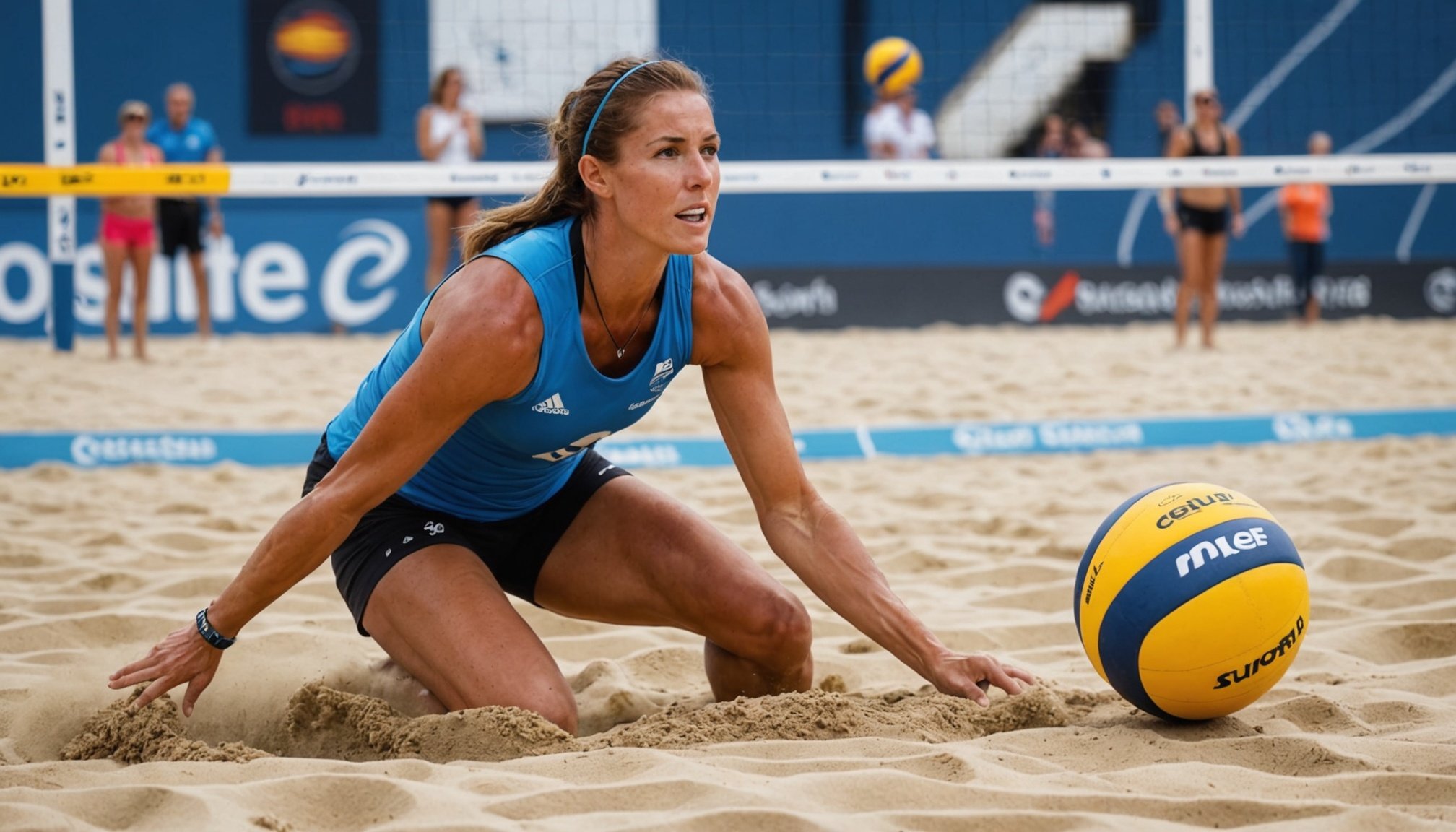Understanding Beach Volleyball Fundamentals
To excel at beach volleyball, mastering the basic skills is crucial. These include serving, passing, setting, attacking, blocking, and digging. Each skill requires precision and control to adapt to the unpredictable beach setting. Unlike indoor volleyball, players must navigate the sand, making agility and stamina essential components of training.
Gameplay strategies are also vital. Beach volleyball involves strategic placement of shots, with players mastering techniques like the cut shot, line shot, and pokey to outsmart opponents. Defensive strategies, such as reading the opponent’s intentions and reacting quickly, can turn the tide in a match.
In the same genre : Empowering diversity and inclusion in uk secondary school sports: creative approaches for lasting impact
The official rules of beach volleyball differ from its indoor counterpart. For instance, matches are usually played with two players per side instead of six, and scoring follows the best-of-three sets format. Understanding these rules is important for anticipating game flow and strategy execution.
Key differences between indoor and beach volleyball extend to techniques as well. For example, in beach volleyball, a more refined approach to hand setting is required due to stricter ball handling rules. Additionally, the use of open-handed dinks is limited compared to indoor games.
This might interest you : Revolutionizing fencing officiating: how video replay empowers uk coaches in match decision-making
Training Techniques for Beach Volleyball in the UK
Before jumping into a game, effective training drills are vital for skill development on sand courts. Practicing specific drills like serve-and-receive patterns and setting simulations can enhance accuracy and adaptability. Sand inherently affects movement, necessitating a focus on stability and coordination.
Enter physical conditioning, where agility and endurance training become paramount. On soft terrain, every leap and sprint demands more energy, pressuring players to build strong core and leg muscles. Exercises like plyometrics and circuit training on sand boost performance, helping you glide through games with ease.
Adaptability in training is crucial, too. The UK’s unpredictable weather calls for preparation in rain, wind, or sun. It challenges players to maintain focus under varying conditions, improving resilience. Using weather simulations during practice can aid in seam transitions between drills, sharpening skills irrespective of external factors.
To achieve peak performance, blend these components. Adopt drills that cater to sand-specific demands, bolster those movements with agility training, and remain undeterred by the weather’s whims. This holistic approach to training ensures a well-rounded development in beach volleyball expertise.
Essential Gear for UK Beach Volleyball Players
When playing beach volleyball in the UK, selecting the right volleyball equipment and beach sports apparel is essential for both performance and comfort.
Footwear and Clothing: Choosing suitable footwear is crucial as the sandy terrain requires grip and flexibility. Sand socks are popular since they offer protection while maintaining agility. Pair these with lightweight, breathable attire such as moisture-wicking tops and shorts, designed to keep you cool and allow freedom of movement.
Beach Volleyballs
Selecting the right volleyball is also important. Different beach volleyballs are available, each suited to specific climates. For the UK, consider options that perform well in cooler, possibly windy conditions. Opt for balls with a durable outer shell to withstand abrasive sand.
Sun Protection and Hydration
Finally, staying protected from the elements is vital. Sunscreen with a high SPF is a must due to the reflective nature of sand and water. A hat and sunglasses will further guard against UV rays. Remember to stay hydrated; a stylish, reusable water bottle can be both eco-friendly and practical, ensuring hydration needs are met throughout play.
Strategies for Adapting to UK Beach Conditions
Playing beach sports in the UK presents unique challenges due to its variable weather and distinct sand textures. Understanding these elements is crucial for a successful game.
In the UK, the often unpredictable weather requires players to develop tactics for dealing with wind. The wind significantly alters the trajectory and speed of the ball. Adopting sand court strategies like adjusting your striking technique to counteract strong gusts can be pivotal. A low, firm shot, for example, is less likely to be swept off course by the wind compared to a high lob.
Additionally, the texture of the sand on UK beaches varies significantly, influencing how players should move. Firmer sand allows for quicker movements, while softer sand provides more resistance, slowing players down. Being adaptable and adjusting footwork according to the sand texture is essential for maintaining agility and balance.
When selecting a suitable beach for your sport, considering the typical weather patterns and sand conditions can offer a competitive edge. Beaches sheltered from the wind can provide calmer playing environments, while those with finer sand may be ideal for players who prefer speed over traction. Choose wisely to optimise your performance.
Insights from Experienced Beach Volleyball Players
Learning from seasoned players can illuminate the path to beach volleyball success. Through interviews with local coaches, we gathered valuable coaching advice. Coaches stress the importance of mastering fundamentals such as footwork and positioning. They suggest pairing skills with consistent training regimens, highlighting the need for both physical and mental preparedness.
From UK players, we found inspiring success stories that underline the impact of dedication. Many of these athletes started their journey with local clubs, where they honed their skills and built endurance. As they progressed, they frequently incorporated new techniques and approaches shared by experienced teams.
While coaching advice is vital, avoiding common mistakes is equally crucial. One frequent error involves neglecting player experiences, leading to improper emphasis on physical over strategic play. Overcommitting to advanced techniques without a solid foundation in basics can hinder progress, a pitfall often seen amongst eager novices.
These expert tips guide aspiring players towards a balanced, strategic approach. By integrating structured training, learning from veterans, and avoiding mistakes, one can enhance their performance on the sandy court. Therefore, prioritising fundamentals, understanding personal strengths, and learning from seasoned players are vital for success in beach volleyball.
Building a Community in UK Beach Volleyball
Joining local volleyball clubs offers numerous benefits. It enhances your skills through regular practice and provides a platform to meet like-minded individuals. Clubs often organize community events that promote socialization and team spirit, essential for a thriving volleyball network.
To fully engage with the community, it’s important to know where to look for tournaments and events. Many clubs have websites or social media pages, frequently updated with upcoming games and gatherings. Additionally, national organizations that oversee volleyball often maintain a calendar of events, making it easier to join in.
Sharing experiences and resources among players is another pillar of the volleyball community. Being part of a collective network opens up opportunities for learning and teaching different playing techniques. Such interactions often lead to long-lasting friendships and partnerships.
Networking within the volleyball sphere can also pave the way for collaborations. Whether organizing tournaments or simply arranging practice sessions, being well-connected can elevate your volleyball experience. The camaraderie and support within these local volleyball clubs encourage players to improve and stay motivated. Joining is a befitting way to nurture your passion and improve your game.
Visual Learning for Beach Volleyball Skills
Learning beach volleyball through video tutorials can be an exhilarating and effective method to enhance your skills. These tutorials often provide access to professional-level instructional content, bringing expert coaching to your home screen. Whether you’re brushing up on blocking techniques or mastering the art of the perfect spike, these resources are invaluable.
To maximize improvement, embrace video analysis as a powerful tool. Breaking down these visuals allows players to identify strengths and areas for development in their technique. It serves not just as a self-assessment tool but also as a platform for strategic enhancements in gameplay. Seeing past performances can help in formulating personalised training plans.
Several platforms offer comprehensive visual aids such as play reviews and strategy guides. These resources are designed to deepen understanding and strategic thinking within the game. By analyzing plays, players can study various formations and anticipate opponent moves, turning theoretical knowledge into practical skills.
Furthermore, recommending online workshops offers an interactive dimension to visual learning. Engage with a community, receive feedback, and participate in live Q&A sessions to truly refine your volleyball prowess. Consider this blend of structured guidance and self-analysis as an engaging educational journey.











